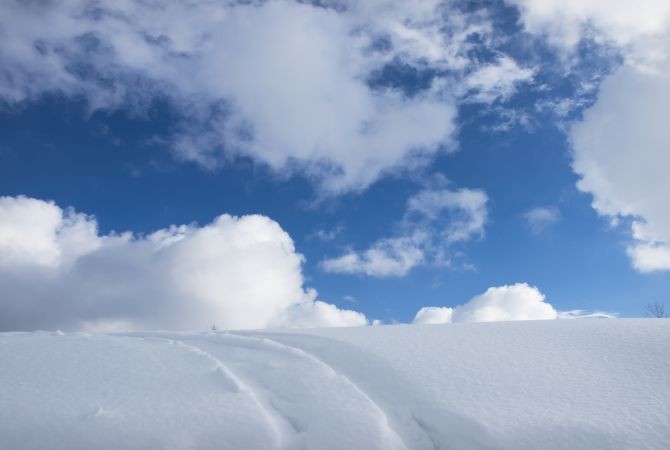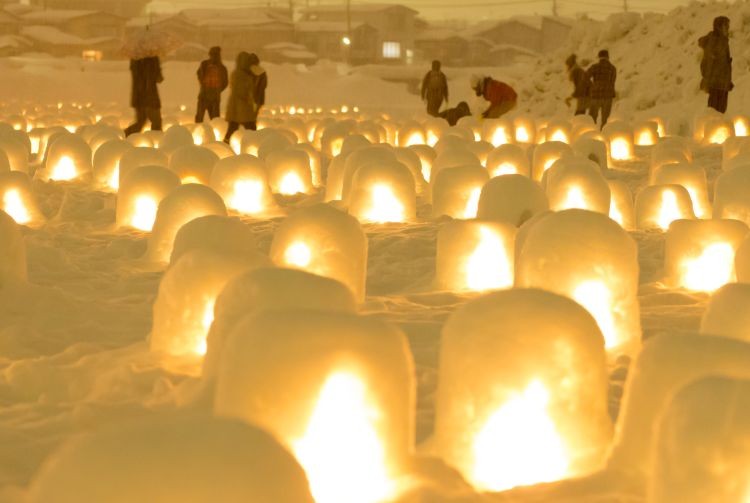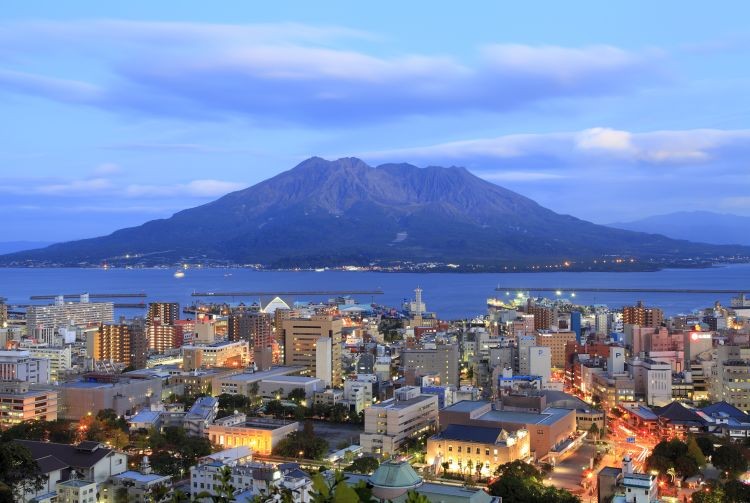Is It Good To Travel To Japan In February? Yes, traveling to Japan in February offers unique experiences, from world-class skiing and snowboarding to captivating winter festivals. TRAVELS.EDU.VN helps you plan your perfect trip, ensuring you don’t miss out on the best winter attractions and cultural events. Discover why February can be an ideal time to explore Japan, with fewer crowds and stunning winter scenery, offering unforgettable winter adventures, cultural immersion, and unique seasonal experiences.
1. Understanding Japan in February: Weather and Climate
Japan in February is characterized by cold weather and snow in many regions, making it a prime time for winter sports enthusiasts. Understanding the weather patterns is crucial for planning your trip.
1.1 Regional Weather Variations
- Hokkaido: Expect heavy snowfall and freezing temperatures, perfect for skiing and snowboarding.
- Tokyo: While snowfall is less frequent, temperatures are cold, averaging between 3°C and 10°C (37°F and 50°F).
- Kyoto: Similar to Tokyo, Kyoto experiences cold temperatures with occasional snowfall, creating picturesque winter scenes.
- Okinawa: In contrast, Okinawa enjoys milder weather with temperatures ranging from 15°C to 20°C (59°F to 68°F), ideal for early cherry blossom viewing.
1.2 Average Temperatures and Precipitation
| Region | Average Temperature (°C) | Average Temperature (°F) | Precipitation (mm) |
|---|---|---|---|
| Hokkaido | -7 to -1 | 19 to 30 | 100-150 |
| Tokyo | 3 to 10 | 37 to 50 | 50-70 |
| Kyoto | 2 to 9 | 36 to 48 | 60-80 |
| Okinawa | 15 to 20 | 59 to 68 | 120-150 |
1.3 What to Pack for February in Japan
Packing the right clothing is essential for a comfortable trip to Japan in February.
- Warm Layers: Include thermal underwear, fleece jackets, and sweaters.
- Waterproof Outerwear: A waterproof and windproof jacket is crucial, especially for snowy regions.
- Accessories: Pack gloves, scarves, and hats to protect against the cold.
- Footwear: Wear waterproof and insulated boots with good traction for walking on snowy or icy surfaces.
- Comfortable Shoes: For indoor activities and exploring cities, comfortable walking shoes are a must.
2. Why Choose February? Benefits of Traveling to Japan in the Winter
Traveling to Japan in February offers several unique advantages that make it an appealing time to visit.
2.1 Fewer Crowds
Compared to peak seasons like spring (cherry blossom season) and autumn (fall foliage), February sees fewer tourists, allowing for a more relaxed and intimate experience of Japan’s attractions.
2.2 Winter Festivals and Events
February is a prime time for experiencing Japan’s winter festivals, which are often spectacular and culturally rich.
2.3 Skiing and Snowboarding Opportunities
Japan is renowned for its excellent powder snow, and February offers some of the best conditions for skiing and snowboarding in world-class resorts.
2.4 Unique Seasonal Cuisine
Winter in Japan brings unique culinary delights, such as hot pot dishes (nabe), seasonal seafood, and warm sake, providing a comforting and authentic dining experience.
3. Must-See Destinations and Activities in February
Japan offers a wide array of destinations and activities that are particularly enjoyable in February.
3.1 Sapporo Snow Festival
The Sapporo Snow Festival is one of Japan’s most famous winter events, featuring impressive snow and ice sculptures. According to the Sapporo Snow Festival official website, the festival attracts over two million visitors each year.
3.2 Skiing in Hokkaido
Hokkaido is a premier destination for skiing and snowboarding, offering some of the best powder snow in the world. Popular resorts include Niseko, Furano, and Rusutsu. Niseko, for example, boasts an average of 15 meters of snowfall per season, according to the Niseko Tourism Association.
 Niseko Ski Resort, Hokkaido
Niseko Ski Resort, Hokkaido
3.3 Visiting Shirakawa-go
Shirakawa-go is a UNESCO World Heritage site known for its traditional gassho-style farmhouses. In February, the village is covered in snow, creating a magical and picturesque landscape.
3.4 Plum Blossom Viewing
While cherry blossoms are typically associated with spring, plum blossoms (ume) start blooming in February, offering a beautiful preview of the coming season. Kairakuen Garden in Ibaraki Prefecture is one of the best places to view plum blossoms.
3.5 Onsen Experience
Soaking in a traditional Japanese hot spring (onsen) is especially enjoyable in winter. Popular onsen destinations include Hakone, Kusatsu, and Beppu.
4. Planning Your Trip: Practical Tips and Considerations
To ensure a smooth and enjoyable trip to Japan in February, consider these practical tips and considerations.
4.1 Booking Accommodation and Transportation
- Accommodation: Book your accommodation well in advance, especially if you plan to visit popular destinations or attend festivals. Websites like Booking.com and Agoda offer a wide range of options.
- Transportation: Purchase a Japan Rail Pass if you plan to travel extensively by train. Reserve your train tickets in advance, particularly for popular routes and during peak travel times.
- Flights: Book your flights early to secure the best prices. Consider flying into major international airports like Narita (NRT) or Haneda (HND) in Tokyo.
4.2 Staying Warm and Comfortable
- Dress in Layers: Wear multiple layers of clothing to adjust to changing temperatures.
- Stay Hydrated: Drink plenty of water to prevent dehydration, especially in dry winter air.
- Use Hand Warmers: Carry disposable hand warmers for extra warmth.
- Warm Drinks: Enjoy hot drinks like green tea, hot chocolate, or amazake (sweet rice wine) to stay warm.
4.3 Understanding Local Customs and Etiquette
- Respectful Behavior: Be mindful of local customs and etiquette, such as removing shoes when entering homes or temples.
- Public Transportation: Avoid talking loudly on trains and buses.
- Tipping: Tipping is not customary in Japan.
- Bathing Etiquette: Follow onsen etiquette, such as washing before entering the bath and not wearing swimwear.
5. February Festivals and Events: A Cultural Deep Dive
February in Japan is filled with vibrant festivals and events that offer unique cultural experiences.
5.1 Sapporo Snow Festival Details
- Dates: Typically held in early February.
- Locations: Odori Park, Susukino, and Tsudome Site.
- Highlights: Massive snow and ice sculptures, snow slides, food stalls, and live performances.
5.2 Yokote Kamakura Festival
- Location: Yokote, Akita Prefecture.
- Dates: Mid-February.
- Highlights: Hundreds of snow huts (kamakura) illuminated with candles, offering a magical and enchanting atmosphere.
 Yokote Kamakura Festival, Akita
Yokote Kamakura Festival, Akita
5.3 Saidai-ji Eyo Hadaka Matsuri (Naked Man Festival)
- Location: Saidai-ji Temple, Okayama.
- Date: Third Saturday of February.
- Highlights: Thousands of men wearing loincloths compete to grab sacred wooden sticks thrown by the priests, believed to bring good luck.
5.4 Haru Matsuri (Plum Blossom Festival)
- Location: Various gardens and parks throughout Japan.
- Dates: Throughout February.
- Highlights: Celebrations of the plum blossom season with traditional music, dance, and food stalls.
6. Skiing and Snowboarding in Japan: Top Resorts and Tips
Japan is a world-class destination for skiing and snowboarding, offering excellent powder snow and a variety of resorts.
6.1 Hokkaido Ski Resorts
- Niseko: Known for its abundant powder snow and extensive terrain.
- Furano: Offers a mix of groomed runs and off-piste skiing.
- Rusutsu: Features three mountains with varied terrain and stunning views.
6.2 Nagano Ski Resorts
- Hakuba: Hosted the 1998 Winter Olympics and offers a range of resorts with challenging slopes.
- Shiga Kogen: One of the largest ski areas in Japan, with multiple interconnected resorts.
6.3 Niigata Ski Resorts
- Myoko Suginohara: Known for its long runs and scenic views.
- Akakan: Offers a mix of on- and off-piste skiing and snowboarding.
6.4 Tips for Skiing and Snowboarding in Japan
- Rent or Bring Gear: Rent ski or snowboard equipment at the resort or bring your own.
- Book Lessons: Consider taking lessons from experienced instructors to improve your skills.
- Check Snow Conditions: Monitor snow conditions and weather forecasts before heading out.
- Stay Safe: Follow safety guidelines and be aware of avalanche risks.
- Enjoy Après-Ski: Relax and unwind after a day on the slopes with onsen and local cuisine.
7. Exploring Japanese Cuisine in February: Winter Delights
Winter in Japan offers a variety of seasonal culinary delights that are perfect for warming up and experiencing local flavors.
7.1 Nabe (Hot Pot)
Nabe is a popular winter dish consisting of a simmering pot of broth filled with vegetables, meat, seafood, and tofu. Common types of nabe include sukiyaki, shabu-shabu, and oden.
7.2 Seasonal Seafood
Winter is the season for delicious seafood such as crab, oysters, and fugu (pufferfish). Many restaurants offer seasonal menus featuring these delicacies.
7.3 Warm Sake
Sake, a traditional Japanese rice wine, is often served warm in winter. It pairs well with nabe and other winter dishes.
7.4 Sweet Treats
Enjoy sweet treats like mochi (rice cakes), zenzai (sweet red bean soup), and taiyaki (fish-shaped cakes) to satisfy your sweet tooth.
8. Alternative Itineraries: Beyond the Snow
If you’re not a fan of snow or winter sports, Japan offers plenty of alternative itineraries for a February trip.
8.1 Okinawa: Island Paradise
Escape the cold and head to Okinawa, where you can enjoy mild temperatures, beautiful beaches, and early cherry blossoms.
- Beaches: Relax on pristine beaches like Emerald Beach and Kondoi Beach.
- Aquarium: Visit the Churaumi Aquarium, one of the largest aquariums in the world.
- Historical Sites: Explore historical sites like Shuri Castle and the Okinawa Peace Memorial Park.
 Okinawa Beaches, Japan
Okinawa Beaches, Japan
8.2 Kyushu: Hot Springs and History
Kyushu, the southernmost of Japan’s main islands, offers a mild climate, rich history, and famous hot springs.
- Beppu: Visit the hot spring town of Beppu, known for its “hells” (jigoku) – unique geothermal features.
- Nagasaki: Explore the historic city of Nagasaki, known for its atomic bomb museum and Glover Garden.
- Fukuoka: Enjoy the vibrant city of Fukuoka, known for its delicious food and Dazaifu Tenmangu Shrine.
8.3 Cultural Experiences in Kyoto and Nara
Even in winter, Kyoto and Nara offer rich cultural experiences with fewer crowds.
- Kyoto: Visit iconic temples and shrines like Kinkaku-ji (Golden Pavilion) and Fushimi Inari Shrine.
- Nara: Explore Nara Park, home to friendly wild deer and Todai-ji Temple, housing a giant bronze Buddha statue.
9. Budgeting for a February Trip to Japan
Planning your budget is crucial for a successful trip to Japan. Here’s a breakdown of estimated costs:
9.1 Accommodation Costs
- Budget: Hostels or guesthouses: $30-$50 per night.
- Mid-Range: Business hotels or Airbnb: $80-$150 per night.
- Luxury: Ryokans or international hotels: $200+ per night.
9.2 Transportation Costs
- Japan Rail Pass: $280 for a 7-day pass.
- Local Transportation: $5-$10 per day for subways and buses.
- Shinkansen (Bullet Train): $80-$150 per trip.
9.3 Food Costs
- Budget: $20-$30 per day for convenience store meals and street food.
- Mid-Range: $40-$60 per day for restaurant meals.
- Luxury: $80+ per day for high-end dining experiences.
9.4 Activity Costs
- Entrance Fees: $5-$15 per attraction.
- Skiing/Snowboarding: $50-$100 per day for lift tickets and rentals.
- Festivals: Free, but may have costs for food and souvenirs.
9.5 Total Estimated Costs
- Budget: $100-$150 per day.
- Mid-Range: $200-$300 per day.
- Luxury: $400+ per day.
10. Conclusion: Is February the Right Time for You?
Traveling to Japan in February offers a unique blend of winter activities, cultural experiences, and seasonal beauty. While the weather can be cold and snowy, the advantages of fewer crowds, stunning winter landscapes, and vibrant festivals make it an appealing time to visit.
10.1 Pros and Cons of Traveling to Japan in February
Pros:
- Fewer crowds compared to peak seasons.
- Excellent conditions for skiing and snowboarding.
- Unique winter festivals and events.
- Beautiful snow-covered landscapes.
- Seasonal cuisine and warm sake.
Cons:
- Cold weather and potential for snowstorms.
- Some attractions may have limited hours.
- Higher costs for ski resorts.
10.2 Final Recommendations
If you enjoy winter sports, cultural experiences, and don’t mind the cold, February can be an excellent time to visit Japan. Dress warmly, plan your itinerary carefully, and be prepared for potential weather disruptions. Whether you’re hitting the slopes in Hokkaido, exploring snow-covered villages like Shirakawa-go, or immersing yourself in the vibrant festivals, Japan in February offers unforgettable memories.
11. TRAVELS.EDU.VN: Your Partner for a Seamless Japan Trip
Planning a trip to Japan can be overwhelming, but with TRAVELS.EDU.VN, you can enjoy a seamless and stress-free experience.
11.1 Tailored Travel Packages
TRAVELS.EDU.VN offers tailored travel packages to suit your interests and budget, whether you’re looking for a ski adventure, a cultural immersion, or a relaxing getaway. Our packages include:
- Accommodation: Handpicked hotels and ryokans to ensure a comfortable stay.
- Transportation: Convenient transportation options, including Japan Rail Pass and local transfers.
- Activities: Curated tours and activities to help you experience the best of Japan.
- Support: 24/7 support from our experienced travel experts.
11.2 Expert Travel Advice
Our team of travel experts has extensive knowledge of Japan and can provide personalized advice to help you plan your perfect trip. We can assist with:
- Itinerary Planning: Creating a customized itinerary based on your interests and preferences.
- Accommodation Recommendations: Finding the best hotels and ryokans for your budget and needs.
- Transportation Logistics: Booking flights, trains, and local transportation.
- Cultural Insights: Providing information on local customs and etiquette.
11.3 Why Choose TRAVELS.EDU.VN?
- Experience: Years of experience in planning trips to Japan.
- Expertise: Knowledgeable travel experts who are passionate about Japan.
- Personalization: Tailored travel packages to suit your individual needs.
- Support: 24/7 support throughout your trip.
- Convenience: Hassle-free planning and booking process.
Don’t let the complexities of travel planning hold you back from experiencing the magic of Japan. Let TRAVELS.EDU.VN take care of all the details so you can focus on creating unforgettable memories.
12. Ready to Plan Your Japan Adventure?
Ready to experience the wonders of Japan in February? Contact TRAVELS.EDU.VN today to start planning your dream trip!
- Address: 123 Main St, Napa, CA 94559, United States
- WhatsApp: +1 (707) 257-5400
- Website: TRAVELS.EDU.VN
Let us help you create a personalized itinerary that includes the best winter festivals, ski resorts, cultural attractions, and culinary experiences Japan has to offer.
13. Frequently Asked Questions (FAQs)
1. Is February a good time to visit Japan for skiing?
Yes, February is an excellent time for skiing in Japan, especially in Hokkaido and Nagano, which offer some of the best powder snow conditions in the world.
2. What should I pack for a trip to Japan in February?
Pack warm layers, including thermal underwear, fleece jackets, and waterproof outerwear. Don’t forget gloves, scarves, hats, and waterproof boots.
3. What are the best festivals to attend in Japan in February?
Some of the best festivals include the Sapporo Snow Festival, Yokote Kamakura Festival, and Saidai-ji Eyo Hadaka Matsuri.
4. How crowded is Japan in February compared to other months?
February is generally less crowded than peak seasons like spring and autumn, allowing for a more relaxed travel experience.
5. What is the average temperature in Tokyo in February?
The average temperature in Tokyo in February ranges from 3°C to 10°C (37°F to 50°F).
6. Is it possible to see cherry blossoms in Japan in February?
While cherry blossoms typically bloom in March and April, you can see early-blooming varieties in Okinawa in February.
7. What are some alternative destinations in Japan if I don’t like snow?
Consider visiting Okinawa or Kyushu, which offer milder climates and a range of attractions.
8. How much does it cost to travel to Japan in February?
Budget travelers can expect to spend around $100-$150 per day, while mid-range travelers should budget $200-$300 per day.
9. Do I need a Japan Rail Pass for traveling in February?
If you plan to travel extensively by train, a Japan Rail Pass can be a cost-effective option.
10. What are some must-try foods in Japan in February?
Try nabe (hot pot), seasonal seafood like crab and oysters, and warm sake.
By addressing these common questions and providing comprehensive information, this guide aims to be a valuable resource for anyone planning a trip to Japan in February. Remember, travels.edu.vn is here to help you create the perfect itinerary and ensure a seamless and unforgettable travel experience. Contact us today to start planning your dream trip!